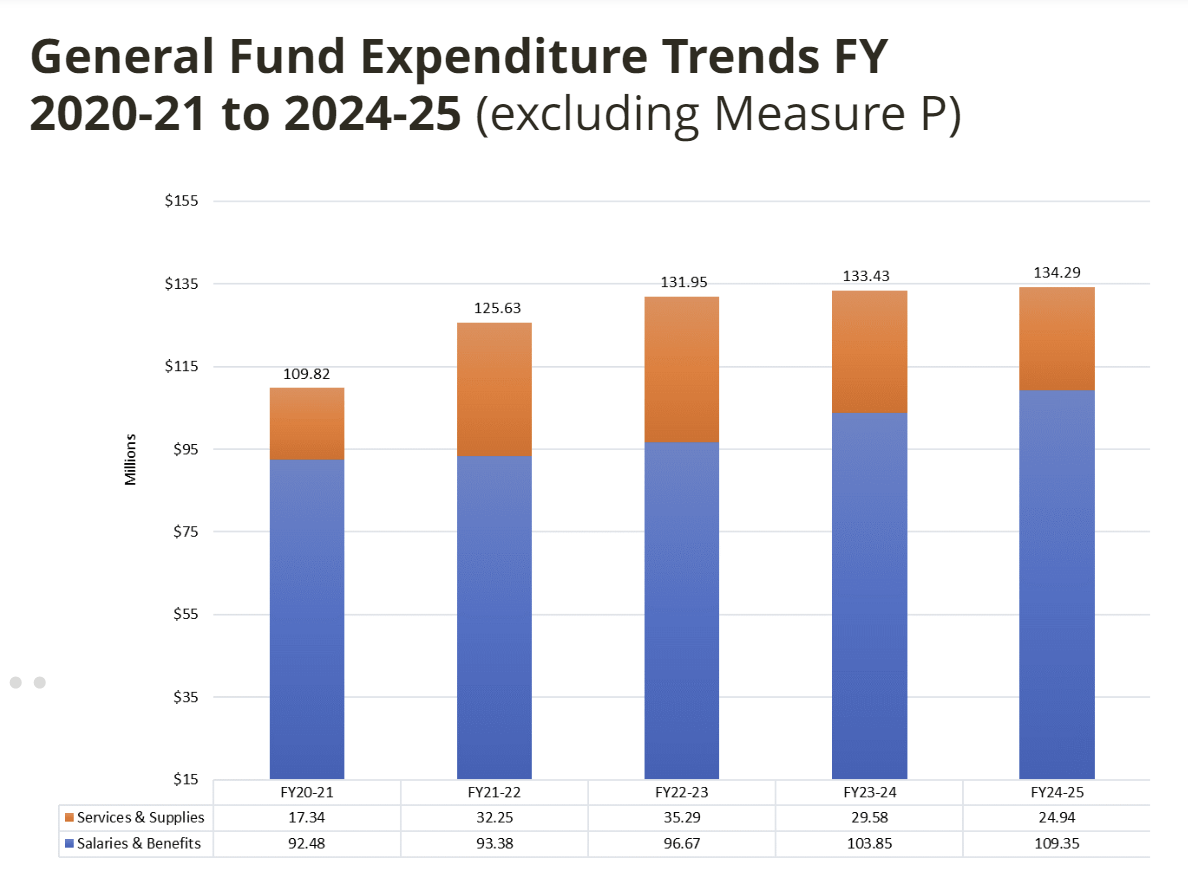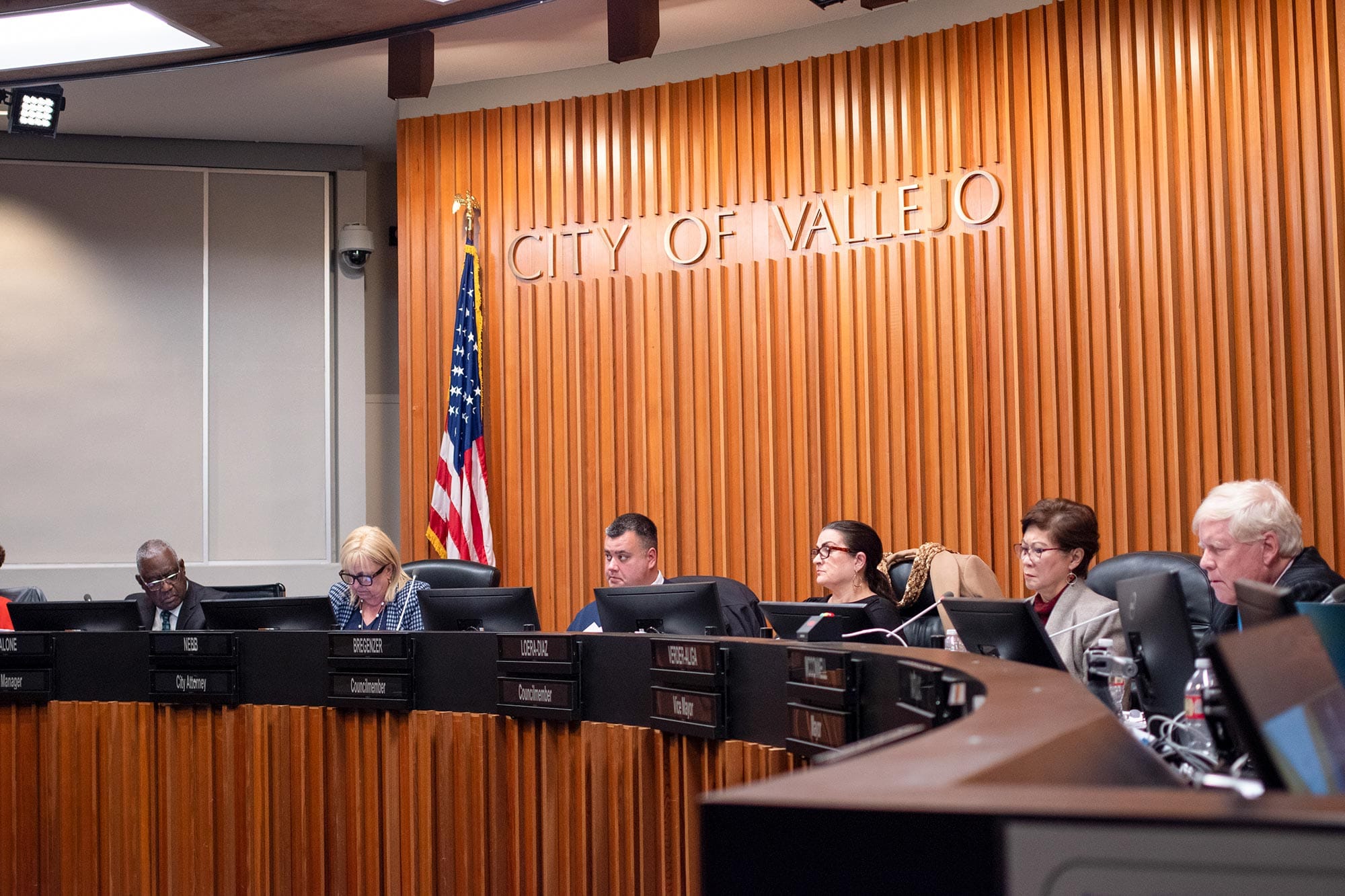VALLEJO – The city of Vallejo’s finance department proposed a 10% cut to services and supplies across all departments to help close a $3.3 million funding gap in the upcoming fiscal year budget.
The city’s finance department estimates that the city’s general fund revenue for the upcoming fiscal year will be $134 million, excluding Measure P sales tax revenue. Although the department’s predictions show a $1.5 million increase in revenue from the previous year, the city estimates expenditures for the 2024-25 fiscal year to be $137.6 million.
To close the gap, the finance department asked the leaders of each department to make a 10% cut at their own discretion to their services and supplies budget allocation. Services and supplies is an allocation in each department budget that accounts for operating costs separate from salaries and benefits.

During a budget workshop meeting last week, Councilmember Mina Loera-Diaz expressed concern about where the cuts would come from in each department.
“I just want to make sure the cuts are not cuts that are affecting the residents directly,” Loera-Diaz said. “So if we are going to eliminate some paper here or some copies there, it’s very different than [cutting] services that we are supposed to be providing.”
Mayor Robert McConnell also expressed interest aligning the budget more closely with council’s spending choices and public priorities, rather than making general cuts to each department.
“The weakness in that system,” McConnell said. “Is that it does not give recognition to the priorities of the citizens or what the council wishes to spend more or less money on. It comes in with an administrative approach to continue what has been done in the past. It does not give an opportunity for the citizens to say we want more roads or we want more festivals.”
During public comment Brenda Plechety of the Marina Advisory Committee said that she has not heard any mention of funding for repairs and dredging of the city’s marina, which is suffering from years of deferred maintenance. Dalia Vidor of the Arts and Culture Commission requested more funding for arts and cultural programs.
Both commenters stressed the economic development value of their respective funding requests and suggested that the lack of funding in each area is a missed opportunity.
Councilmembers expressed support for funding marina repair and arts and culture and asked staff to look for ways to find funding for both areas during the mid-year budget adjustment process that takes place in December.
“Since arts and culture is intrinsically connected to economic vitality, it’s imperative that we invest some portion of our budget,” Councilmember Cristina Arriola said.
Early on in the workshop Loera-Diaz requested an explanation of what happens with funding that is earmarked for the numerous vacant positions throughout the city, such as short staffing in the police department, which led the council to declare an emergency last year.
“There is a large amount of money allocated to the Police Department," Loera-Diaz said. “And we do not have a lot of officers. People are under the impression that there are these funds there, ready to be utilized, when and if we are able to hire later on. What exactly happens with that money that is not being utilized?”
Finance Director Rekha Nayer said that the current budget allocates $6.6 million for vacant positions and at mid-year the staff looks at the actual vacancy from July to December and based on that vacancy they reallocate the $6.6 million across all the departments.
In previous meetings, planning department director Christina Ratcliffe and Interim Police Chief Jason Ta, both of whose departments have a number of vacant positions, noted that the reallocated salary savings from vacant positions can end up going to pay overtime for officers who cover vacant shifts or contractors hired due to short staffing.
McConnell pointed out that while the city is facing a staffing crisis across all departments, under the proposed budget, the human resources department will face cuts that could hamper the department's ability to improve the staffing levels citywide.
Human Resources Director Stephanie Sifuentes said that to accommodate the budget constraints in her department she eliminated two management roles in favor of lower level positions. She plans to use that staff to create multi-disciplinary HR teams for each department so if they do end up having to accommodate more vacancies the structure will be more resilient.
Sifuentes said that she will ask for more staff at the next opportunity because her department is struggling with the limited number of positions.
Nayer said that the city has budgeted carefully for nearly a decade to build up a reserve fund, which she said increases public confidence that the city can survive fiscal emergencies and allows the city to secure better interest rates on the bond market when funding major capital projects like street repair or the new police station.
Nayer said that this year’s budget maintained that reserve fund at 17.9% of total expenditures, which is within recommended reserve guidelines.
However, Councilmember Peter Bregenzer pointed out that over the five-year projection the city would be running a deficit over the next four years without revenue from Measure P, a sales tax hike passed by voters in 2022.
Measure P revenue is part of the city’s general fund but many of the budget tables show the Measure P funds separately because they are allocated through a separate process of committee recommendation and council approval.
In the 2024-25 fiscal year, Measure P is expected to bring in $18 million in revenue. Only $4 million of that has been recommended for allocation by the Measure P Oversight Committee so far.
Bregenzer said that city officials need to take a long hard look at programs that are not providing benefits or are not generating revenue and find ways to reduce spending. He said that balancing the budget on salary savings puts the city in a precarious position and that it would be better to have those funds for projects like the dredging and repairing the marina.
“I keep hearing that we have more and more needs and more and more requests,” Bregenzer said. “And we just keep adding them to it or trying to find money here or money there to try and cover things but we can’t continue down this road. I think we are headed to a very serious situation if we don’t take action now.”
The council will hold a public hearing for adoption of the proposed budget on Tuesday.
Before you go...
It’s expensive to produce the kind of high-quality journalism we do at the Vallejo Sun. And we rely on reader support so we can keep publishing.
If you enjoy our regular beat reporting, in-depth investigations, and deep-dive podcast episodes, chip in so we can keep doing this work and bringing you the journalism you rely on.
Click here to become a sustaining member of our newsroom.
THE VALLEJO SUN NEWSLETTER
Investigative reporting, regular updates, events and more
- government
- Vallejo
- Vallejo City Council
- Vallejo City Hall
- Mina Loera-Diaz
- Robert McConnell
- Measure P
- Cristina Arriola
- Brenda Plechaty
- Dalia Vidor
- Peter Bregenzer
- Christina Ratcliffe
- Jason Ta
- Stephanie Sifuentes
- Rekha Nayar

Ryan Geller
Ryan Geller writes about transitions in food, health, housing, environment, and agriculture. He covers City Hall for the Vallejo Sun.
follow me :




